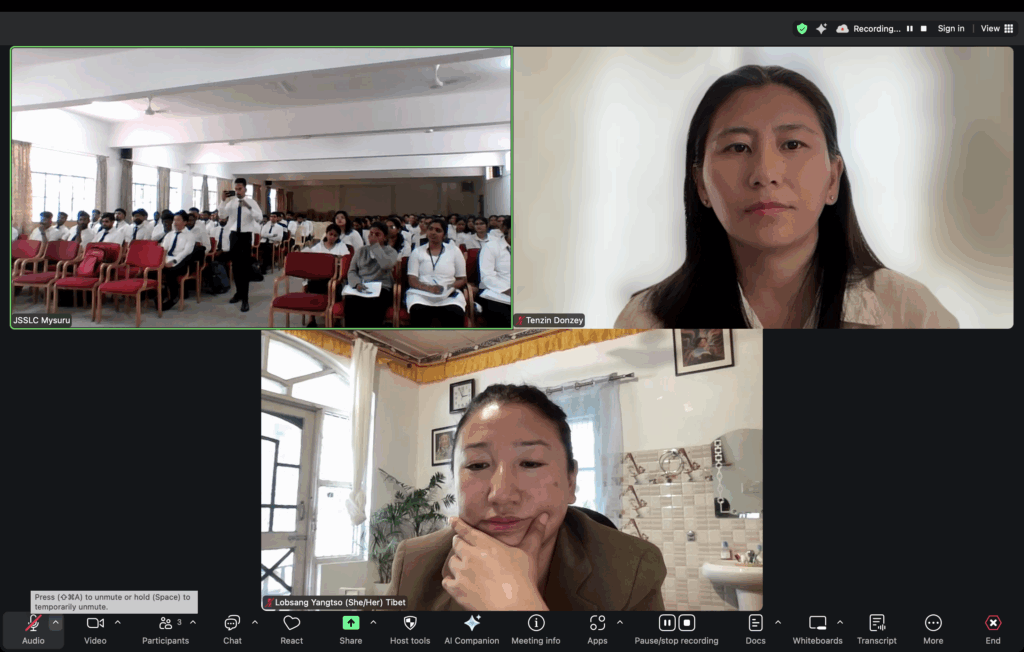October 15, 2025 — The 108 Peace Institute, in collaboration with J.S.S. Law College (Autonomous), Mysuru, hosted a virtual lecture on “Climate Change in Tibet and Water Security in India: Challenges and Strategic Responses.” The session featured Dr. Lobsang Yangtso, senior researcher at the International Tibet Network, who spoke on the urgent environmental and geopolitical issues emerging from the Tibetan Plateau.
Dr. Yangtso opened the session by emphasizing the critical importance of the Tibetan Plateau, often called the “Water Tower of Asia,” for its role in sustaining the continent’s major rivers—the Indus, Brahmaputra, Mekong, Sutlej, Salween, Yellow River, Yangtze, Karnali—which together support nearly half of the world’s population.
She noted that the region has become the center of “geopolitical and environmental anxiety” due to climate change and rapid infrastructure development, particularly China’s plans to construct a massive hydropower project on the Yarlung Tsangpo, known downstream as the Brahmaputra. “The fragile Himalayan balance is being altered, threatening ecosystems, livelihoods, and regional stability,” she warned.
Tracing the river’s journey, Dr. Yangtso explained that the Brahmaputra originates from the Angsi Glacier near Lake Manasarovar in Tibet, at an altitude of 5,300 meters, flowing 1,700 kilometers through Tibet before entering India’s Arunachal Pradesh as the Siang River. “In Arunachal, the river is both sacred and life-giving,” she said. She also highlighted the Pemakoe region—straddling Tibet and Arunachal Pradesh—as a sacred Beyul, or hidden paradise, blessed by Guru Padmasambhava, an Indian saint revered in Tibetan Buddhism.
Beijing’s Megadam Ambition
Dr. Yangtso drew attention to China’s announcement on December 25, 2024, of the Metog Hydropower Project, to be built at the Great Bend of the Yarlung Tsangpo in Tibet. The proposed project, she said, “poses a huge risk to an already fragile ecosystem in one of the world’s most seismically active zones.”
She cited the 7.8-magnitude earthquake that struck Shigatse earlier this year—just 30 kilometers from the proposed dam site—as evidence of the area’s instability. “The Chinese government has not released any Environmental Impact Assessment Report,” Dr. Yangtso noted. “It is not even known if such an assessment was carried out.”
Regional Concerns: India and Bangladesh on Edge
Dr. Yangtso outlined the growing anxiety in India and Bangladesh, both heavily dependent on the Brahmaputra. “India fears disruptions in water flow and the potential ‘weaponization of water’ by Beijing,” she said. “The dam could allow China to manipulate the river—holding or releasing flows during critical agricultural seasons—affecting millions downstream.”
In Bangladesh, which receives the river as the Jamuna, the stakes are equally high. Over 85 million people rely on the Brahmaputra basin for farming and fishing. Dr. Yangtso added that the absence of a formal water-sharing treaty between India and China exacerbates these vulnerabilities. The only existing mechanism—the Expert-Level Mechanism (ELM) for hydrological data sharing—has faced disruptions, with the last memorandum expiring in June 2023.
India’s Strategic Countermove
Dr. Yangtso also discussed India’s plan for the Upper Siang Multipurpose Storage Project near Geku village in Arunachal Pradesh, valued at US$13.2 billion with a proposed capacity of 11,000 MW. “This project aims to ensure water security, generate renewable power, and mitigate floods,” she said, “but it has not yet taken off due to protests from local communities.”
She observed that international law provides limited recourse in such disputes. “Without a binding treaty, India and China operate largely on political goodwill,” she noted, emphasizing that any transboundary river management must uphold the principles of free, prior, and informed consent of affected indigenous communities.
A Fragile Future
Concluding her lecture, Dr. Yangtso warned that “the combined pressures of climate change, seismic instability, and the ongoing dam-building race could lead to irreversible ecological collapse.” She called upon India and Bangladesh to take diplomatic steps to prevent China from moving ahead with the Metog project. “If this dam is built,” she said, “it will inevitably lead to a disastrous future—not only for Tibet but for millions living downstream.”
The session concluded with a lively Q&A, where students and faculty members engaged with Dr. Yangtso on issues ranging from international law to indigenous rights. Around 70 participants attended the virtual lecture.

